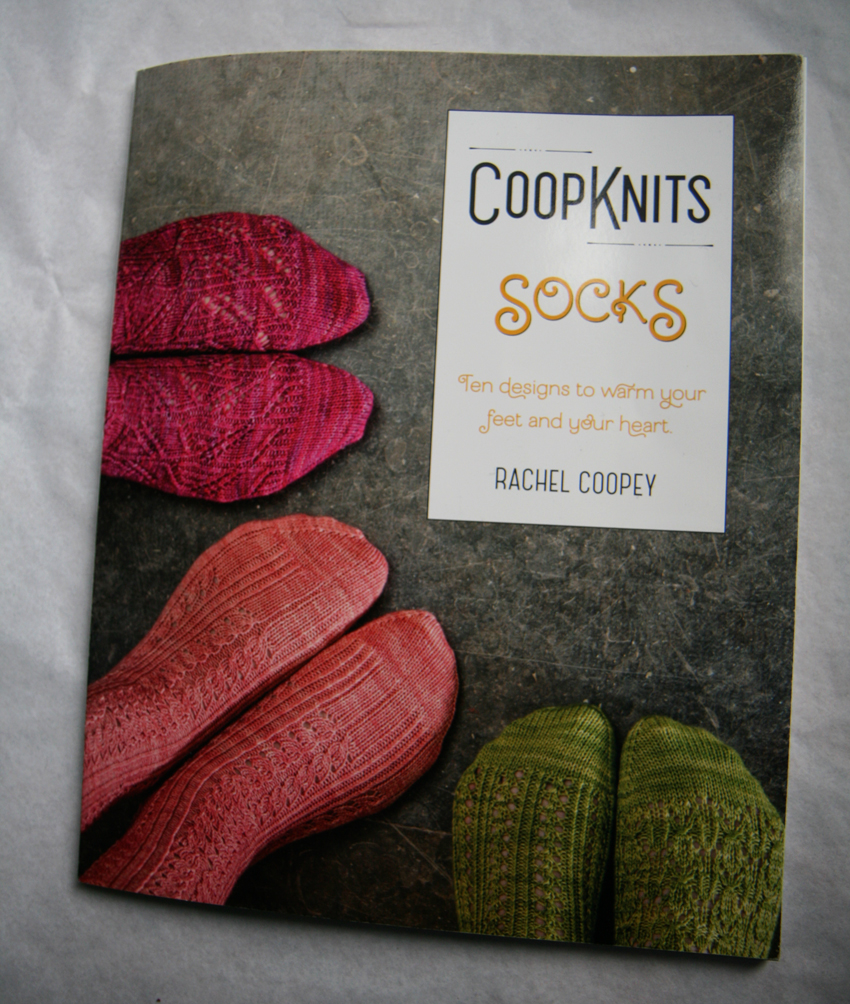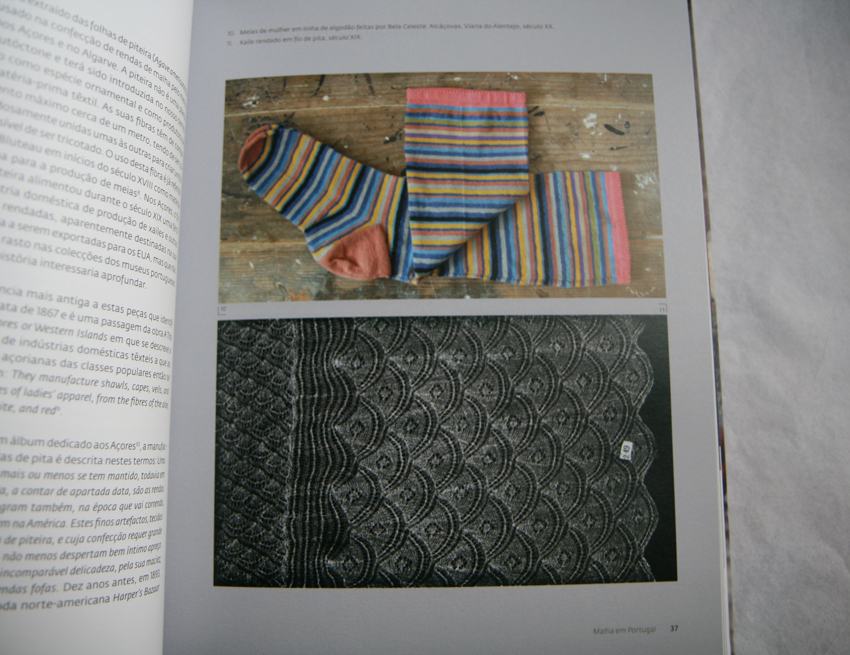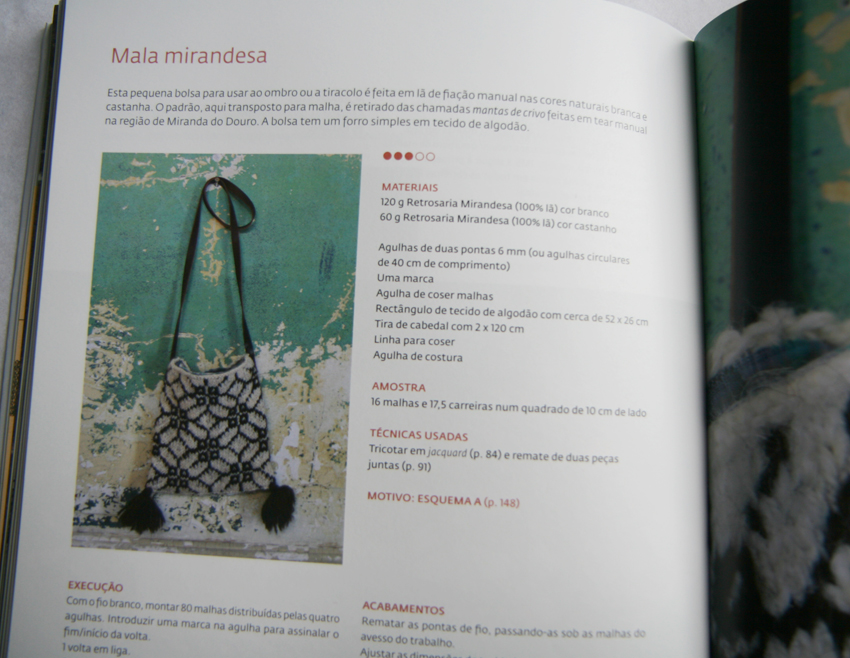I’ve been really inspired by some fantastic knitting books which have turned up here recently, so I thought I’d give them a shout-out. First up is Rachel Coopey‘s much anticipated first collection. Rachel is truly the Queen of Socks — she has a distinctive feel for pattern and structure which suits her foot-shaped canvas perfectly. Her designs are thoughtful, precise and definitively knitterly — she often reverses or mirrors stitch patterns across her socks in ways that are not only aesthetically pleasing but will really engage the maker’s interest through a pair. For example, Milfoil (the green pair that you can see above), has a horizontal mirror between cuff and foot that makes each sock the opposite of the other, while in Budleigh (my favourite design in the collection) neat cables and twisted stitches flow through the design with a vertical reflection that separates left from right.
Inside the book are ten beautifully written and laid-out patterns; a technical section with instructions for essential sock-knitting techniques (including a useful illustrated afterthought heel-tutorial) and jolly English seaside photography. What’s not to love?
You can pre-order the book directly from Rachel here.
Next up, and top of the tree for pure knitterliness, is Lynne Barr’s new book, The Shape of Knitting. Lynne has an amazingly innovative approach to stitch, and I think she is one of the most creative and inventive designers around today.
My approach to design tends to be very referential. I see a thing, or read a thing, or hear a thing — I like the thing — and I want to somehow render, or celebrate, or get to the heart of the thing in stitches. Lynne’s approach is completely different, and I completely love it. She says:
Inspiration isn’t always derived from things we see around us — or even from words we read or hear. Sometimes it comes from something intangible within us. When playing with a technique, I sometimes feel like a dowser, but holding knitting needles instead of a dowsing rod to guide me toward an unknown goal.
I feel about two hundred years behind Lynne’s design-aesthetic — a plodding Wordsworth to her John Ashberry. Don’t get me wrong — I love the technical aspects of designing, and I like to make stitches do things for me, but I think that Lynne’s relationship to stitch is on another level entirely — like the listener of a symphony who has somehow become a sort of instrument themselves. If you have any interest in the creative possibilities of knitwear design, then you need to immediately get hold of a copy The Shape of Knitting to put on your shelf next to Lynne’s previous book.
Finally, here is a book I’ve been looking forward to seeing for some time.
I admire Rosa Pomar for many reasons, but perhaps most for her thorough commitment to exploring and documenting the history of Portuguese textiles from the grass-roots up. Behind this wonderful book stands several years work, as Rosa has travelled around Portugal, researching animal husbandry, spinning, weaving, knitting, garment construction, and the traditional craft and design practices of men and women all over her beautiful country. Though my Portuguese is non-existent, I still find so much food for thought here.
As well as exploring the history and distinctive techniques of Portuguese hand knitting, the book also includes patterns for twenty lovely accessories inspired by traditional design. I think that this one is my favourite . . .
. . . not least for the way it showcases Rosa’s own Mirandesa yarn, which is hand spun and plied in Trás-os-Montes from the wool of Churra Galega Mirandesa sheep. This book marks an important landmark in the way the history of hand knitting is researched and written about, and you can buy it from Rosa here.










Oh, you have so lead me astray, I am now the proud owner of coop knit socks!!
LikeLike
Thx Kate, Rachel Cooper’s socks always remind me of Pablo Neruda’s sparkling poem ‘Ode to my Socks’ where he celebrates the joy, colour & fun of a gift of hand knitted socks. It begins:
” Maru Mori brought me
a pair
of socks
which she knitted with her own
sheepherder hands,
two socks as soft
as rabbits.
I slipped my feet
into them
as if they were
two
cases
knitted
with threads of
twilight
and the pelt of sheep……….”
LikeLike
thanks so much! The poem is so good I’ve posted it separately.
LikeLike
These sound like some great recommendations…I shall endeavour to look out for them!
LikeLike
But I already spent my book budget this month!
LikeLike
Thanks for posting about the Portuguese book, I wouldn’t have known about it otherwise, have just ordered! I’m very interested in Portuguese culture, and speak a little Portuguese, so can’t wait to read it!
LikeLike
I feel very referential as well, especially when I’m inspired by designers like you! But keeping traditional techniques and styles alive, and reinterpreting them for modern use, is a very important thing. There’s a lot to be said for designing and creating items of beauty for everyday use.
LikeLike
I love socks and knit them constantly, especially Estonian socks from Nancy Bush’s book, Folk Knitting in Estonia. The pattern is so perfect that I could almost knit them in my sleep. Peerie Flooers decorating socks, what fun! My fear is that my family and friends may get tired of being inundated with socks, but they are addictive.
LikeLike
Sigh…I keep telling myself “no more knitting books” and here you come with some more! One of the good things about good knitting books is that at least some of the language is “universal”!
LikeLike
Thanks Kate, it’s always interesting to find new knitting books. I’m a sock addict in Australia, so Rachel’s book will soon be on order, and it will be good to see the English countryside again. I loved seeing Scotland in your book. Keep well.
LikeLike
First of all………..it was great to hear from you again. I was starting to get a little anxious :)
Thanks for great reviews, maybe the Portuguese book will be translated. That is definitely intriguing.
And that hat…………how cool is that!
LikeLike
Thank you Kate! I’m so happy you liked the book. I’m in Santa Maria, Azores, right now. We’ve interviewed a group of spinners today. Until a few decades ago they traded fisherman sweaters made from handspun wool were an important part of their income. These sweaters were sold to other islands and worn by all local fiahermen. I will post some videos when I return.
LikeLike
Thank you Kate for your educational posts ! It allways is good to have references to go by . . .
LikeLike
Mmmm. Nice. Thank you.
LikeLike
Definitely thanks for the recommendations – the last two have definitely captured my imagination (I just don’t do socks!).
LikeLike
Thank you so much! I have been learning to knit socks and now on sock no. 8. Completely fascinated. Just tried twisted German cast on yesterday and got unfeasibly excited. The thought of mirror image socks very compelling although not sure how this fits with my daughter’s odd sock ethos/habit. Also, Portuguese GF so will be unable to resist that book. I wondered if I could ever aspire to adding a row of your peerie floo’ers into the cuff of a sock. Feel that may be a few socks away…
LikeLike
I do love a thing too. So many beautiful books. Thanks, as ever, for the introduction to new things.
LikeLike
Great to see some knitting books recommended, I love knitting books but often feel unsure about which ones to choose so often order them in to the library so I can see them before ordering them online. Thanks for the great reviews, I feel so tempted by the ones you’ve mentioned here!
LikeLike
Thank you for your good advices. I just ordered the book of Rosa Pomar because I am deeply interested in history of technics, history of knitting and, basically, all traditional domestic arts. My portugese is very poor but, with a good dictionary and a lot of interest, I am sure I will manage to learn what Rosa has to say to us.
LikeLike
I love Lynn Barr too!
LikeLike
So many lovely books. I’m intrigued by the sculpture element to the shape of knitting but I think it’s the socks that call my name!
LikeLike
I have been looking forward to Rachel Coopey’s book for a while, but I hadn’t heard of either of the others. The book about Portuguese knitting sounds fascinating, and would be a good place for me to try practicing my very limited Portugese. The Shape of Knitting probably wouldn’t appeal to my wardrobe aesthetic, but in terms of learning new things and thinking differently about what you can make stitches do, it sounds like a must-read.
These three books encapsulate everything a love about knitting: beautiful practicality, something new and amazing to learn, and history. It makes me happy to be a knitter.
LikeLike
in different ways they all seems to have interesting aspects: in The Shape of Knitting her new approach and modern knit fashion, in Malhas Portuguesas the insight in traditional patterns and wool creation and Socks would appear to bring a new layer to sock making. Thanks for introducing those books. I like when we can look at knitting from very different view points and approaches, it enables creative thinking and diversity
LikeLike
Over the last week or so I’ve been very much appreciating your referential approach. I’m working on “Deco” and as I stitch imagining the architectural images “referenced” in that design. Lovely!
LikeLike
Just orderd my copy of the shape of knitting….looks really intresting ! Nice post
LikeLike
Thank you for your thoughtful recommendations. I will be looking for these books.
LikeLike
Great post. Must have books—thanks so much for sharing.
LikeLike